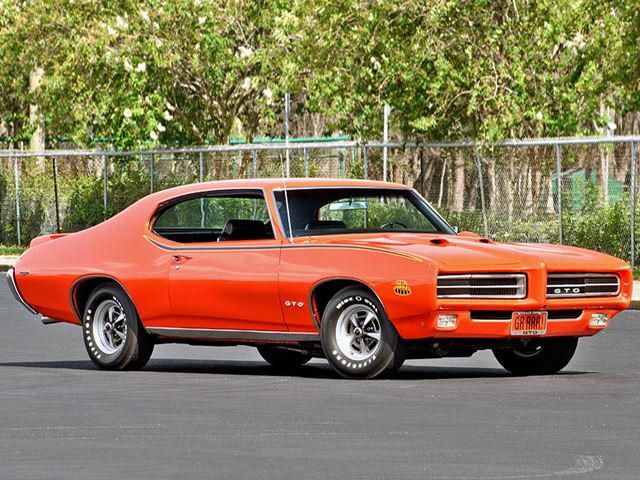The arrival of the muscle car came about thanks to a number of cultural phenomena all happening at the same time. Large numbers of young men, having returned from World War II, had newfound purchasing power, wanted cars that were striking and fast. They wanted nothing to do with the old-fashioned wagons their parents drove, so a change in the automotive industry was necessary.
With abundant, cheap fuel, running costs were not a major concern. It would also be another couple of decades before emissions and environmental impact appeared on the radar.
This combination of factors led to the rapid rise of the muscle car as the quintessential, all-American vehicle. Every automaker wanted a piece of the pie, and several brands began to launch models with aggressive looks and large, thundering engines, preferably V8s. While several of these brands, especially major ones like Ford and Dodge, and Chevrolet have survived to the present day, others weren’t so lucky, and began to disappear in the decades following the muscle car’s heyday. Let’s explore some of these now-defunct brands.
This feature includes some of the brands that built muscle cars over the decades, but are no longer in existence.
Pontiac
Pontiac first arrived on the market in the 1920s, being created as part of GM’s “companion make” program which was just beginning to take off. It was originally meant as a sub-brand for parent company Oakland, but it ended up overtaking it in terms of success and longevity. A few decades later, Pontiac launched what would become one of the most iconic models of the muscle car world: the GTO. Alongside other legendary models, such as the Ford Mustang and Dodge Charger, the GTO was at the core of the muscle car market, combining visually striking lines with a large power output.
Despite becoming famous as a model in its own right, the GTO actually started out in life as an option package. At the start of the ’60s, the Tempest-based Pontiac Le Mans offered an optional “GTO package.” In 1966, the GTO name was used for a standalone model which remained on the market until 1971.

Related
Pontiac Muscle Cars: Exploring The Icons Of American Automotive Muscle
A look at Pontiac’s muscle cars that have become part of American automotive history.
Around the same time, Pontiac also launched another muscle car, with a slightly less exciting name but a higher power output. The 2+2, which produced 376 hp against the GTO’s 325. Like the GTO, the 2+2 name originally started out as a trim option on another car, the Catalina, but quickly became a model in its own right, being advertised as the GTO’s “big brother”.
Pontiac’s successful streak carried on into the 1980s, but the following decade brought a change of fortune for the company, whose popularity began to decline. Pontiac lasted a little longer than other GM brands, but still struggled badly at the turn of the millennium; in 2009, it was eventually killed off along with Saturn, Hummer, and Saab.
Oldsmobile
Oldsmobile may not be the first name that comes to most people’s minds when thinking about muscle cars. However, the brand is responsible for reaching several important milestones in automotive history, including what is believed to be the very first muscle car on the market, the “Rocket” 88.
The long, rich history of Oldsmobile starts in 1897, not long after the invention of the car itself. In 1908, the company was acquired by General Motors, joining its rapidly growing roster of brands. Throughout the first half of the 20th century, Oldsmobile grew in popularity, becoming one of the biggest names in the American car market. In 1948, a revolutionary model was launched: the 88, soon to be nicknamed the “Rocket 88” after the V8 engine of the same name that powered it.
The Rocket 88’s striking, aggressive looks, combined with a large V8 and a high power output, meant it was the earliest model to meet the criteria for what is considered a “muscle car” today. It was marketed towards young people, carrying an image of carefree, road-trip freedom: another cultural hallmark of the muscle car era. The 88 also had a strong presence in the world of NASCAR, which further added to its “fun and fast” reputation.
Oldsmobile began to fall out of favor with the public in the late 1980s, and by the following decade the decline was terminal. The company’s history ended with the 2004 Alero, the last model to roll off an Oldsmobile production line.
Studebaker
Now an all-but-forgotten name, Studebaker was once a major brand in the American car market; the company’s history actually stretches further back than that of the car itself, as Studebaker originally built horse-drawn carriages in the late 19th century. Its very first cars were electric, but eventually switched to combustion as gas-powered engines took over at the start of the 20th century.
By the time Studebaker started to produce cars that could be included within the “muscle” category, the brand was already struggling badly. An early-50s takeover by smaller automaker Packard, also now defunct, did not provide the expected economic boost, while an attempted collaboration with Porsche came to nothing. The Studebaker name limped on throughout the early ’60s, before the brand was shut down for good in 1966.
Some of Studebaker’s models that fit the bill of a “muscle car” include the Golden Hawk and the Lark. The Golden Hawk represented a change of direction for the brand; up until the mid-50s, Studebaker had focused on budget-friendly alternatives to popular luxury vehicles of the time. The Lark, meanwhile, was a dark horse whose unassuming appearance concealed bucketloads of performance. Rumor has it that the Lark’s engine was in fact Ford’s 289 V8, the same one used in the Mustang at the time.

Add CarBuzz to your Google News feed.
AMX
AMC was only active for less than forty years, but the brand managed to leave its mark on the history of muscle cars. One ancestor of the muscle car, the Rambler Rebel, was built by AMC in the late 50s; despite its bulky, unassuming looks, it was powered by a 5.4-liter V8 that produced 255 hp. Granted, it did not have all the characteristics of a muscle car: its visual profile did not exactly evoke speed and power, and it had four doors. Still, it represented a step towards the emerging muscle car category, which would explode on the market just a few years later.
Around a decade later, in 1960, AMC released the Javelin. This time, all the ingredients for a “proper” muscle car were there, including the slim, aggressive silhouette, a response to models like the Camaro and Mustang. The Javelin was also known for being very lightweight at only 2,836 pounds, which combined with up to 225 produced a formidable combination. An optional “Go Package” swapped in a larger engine, which increased the Javelin’s output to 325 hp.
Another muscle car in AMC’s roster, being sold at the same time as the Javelin, was the smaller AMX; the AMX was based on the Javelin but 12 inches shorter, with only two seats instead of four. The AMX (which stood for “American Motors Experimental”) was known for its agility and nimbleness, competing with models such as the Chevrolet Corvette.
Mercury
This is one brand that isn’t commonly associated with muscle cars, but it still carved itself a small place in the muscle car world. One of Ford’s subdivisions, Mercury was first created in 1938. For the first few decades, it enjoyed a good level of popularity with the American public, and in the early 1950s it was the sixth most popular car brand in the US.
Mercury’s place in the market became more precarious in the ’70s and ’80s, as the oil crisis struck and the public’s preference shifted towards more efficient, compact cars. Ford reworked Mercury’s lineup throughout the rest of the 20th century, in an attempt to reverse its fortunes and bring sales back to their former glory. This strategy was not effective, and Mercury limped on for another few years before eventually being discontinued in 2011.
Mercury’s venture into the world of muscle cars came in the form of the Comet Cyclone, the beefed-up version of the Comet sedan, which arrived on the market in 1964. The following year, the Comet borrowed the Mustang’s engine, which could produce 225 hp in standard form and up to 271 with the optional “Hi-Po” package. A few years later, the “Comet” name was dropped from the Cyclone, making it a standalone model.
Mercury is also responsible for one of the most slept on muscle cars ever made.
Plymouth
Plymouth was first founded in 1928 and rapidly became a major brand in the US car market, enjoying a good degree of popularity up until the 1970s. Afterward, its fortunes began to shift, and the brand began selling rebadged Fords. The decline continued until the turn of the millennium, when the Plymouth name was killed off for good.
The brand produced several muscle cars throughout its existence, including the Belvedere and Belvedere Satellite, the Barracuda, the Superbird, and the Fury (which also earned itself a place in pop culture thanks to Stephen King’s infamous literary creation, a demonically possessed 1958 Fury called Christine.
Part of the reason why King chose the Fury as his protagonist was that, while still being a muscle car, it was not as well-known or popular as other models like the Ford Mustang. Plymouth had a reputation for building vehicles at the more affordable end of the market, offering fun, fast, good-looking cars while still being accessible to the wider public.
The Barracuda has also left a modern legacy behind in the form of a curious Dodge Challenger restomod, which paid homage to the ‘Cuda in 2023. A pair of Challengers sporting different color schemes featured a number of cosmetic modifications that evoked the Plymouth’s striking looks.
Sources:
Precision Car Restoration, GM, Hippo Leasing




